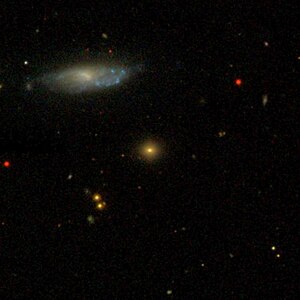NGC 297
| Galaxy data from NGC 297 |
|
|---|---|

|
|
| NGC 298 & NGC 297 SDSS image | |
| AladinLite | |
| Constellation | whale |
|
Position equinox : J2000.0 , epoch : J2000.0 |
|
| Right ascension | 00 h 54 m 58.9 s |
| declination | -07 ° 20 ′ 59 ″ |
| Appearance | |
| Morphological type | cE3: |
| Brightness (visual) | 15.5 mag |
| Brightness (B-band) | 16.5 mag |
| Angular expansion | 0.3 ′ × 0.2 ′ |
| Position angle | 95 ° |
| Surface brightness | 12.5 mag / arcmin² |
| Physical data | |
| Redshift | 0.050778 ± 0.000150 |
| Radial velocity | 15,223 ± 45 km / s |
|
Stroke distance v rad / H 0 |
(683 ± 48) · 10 6 ly (209.3 ± 14.7) Mpc |
| history | |
| discovery | Albert Marth |
| Discovery date | September 27, 1864 |
| Catalog names | |
| NGC 297 • PGC 3243 • 2MASX J00545892-0720591 • GC 5124 • NSA 128011 | |
NGC 297 is an elliptical cD galaxy of Hubble type E3 in the constellation Cetus south of the ecliptic . It is estimated to be 683 million light years from the Milky Way and about 60,000 light years in diameter .
The galaxies NGC 293 and NGC 298 are located in the same area of the sky .
The object was discovered on September 27, 1864 by the German astronomer Albert Marth .
